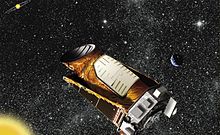ผลต่างระหว่างรุ่นของ "กล้องโทรทรรศน์อวกาศเคปเลอร์"
ไม่มีความย่อการแก้ไข ป้ายระบุ: แก้ไขจากอุปกรณ์เคลื่อนที่ แก้ไขจากเว็บสำหรับอุปกรณ์เคลื่อนที่ แก้ไขขั้นสูงด้วยอุปกรณ์เคลื่อนที่ |
ไม่มีความย่อการแก้ไข ป้ายระบุ: แก้ไขจากอุปกรณ์เคลื่อนที่ แก้ไขจากเว็บสำหรับอุปกรณ์เคลื่อนที่ แก้ไขขั้นสูงด้วยอุปกรณ์เคลื่อนที่ |
||
| บรรทัด 1: | บรรทัด 1: | ||
{{Infobox Space Telescope |
{{Infobox Space Telescope |
||
| name = '' |
| name = ''กล้องโทรทัศน์อวกาศเคปเลอร์'' |
||
| image = [[ไฟล์:Telescope-KeplerSpacecraft-20130103-717260main pia11824-full.jpg|frameless]] |
| image = [[ไฟล์:Telescope-KeplerSpacecraft-20130103-717260main pia11824-full.jpg|frameless]] |
||
| caption = ภาพวาดจินตนาการของกล้องโทรทรรน์อวกาศเคปเลอร์ |
| caption = ภาพวาดจินตนาการของกล้องโทรทรรน์อวกาศเคปเลอร์ |
||
| บรรทัด 26: | บรรทัด 26: | ||
'''กล้องโทรทัศน์อวกาศเคปเลอร์''' ({{lang-en|Kepler}}) เป็น[[กล้องโทรทรรศน์อวกาศ]]ของ [[นาซ่า]] ที่ค้นพบ[[ดาวเคราะห์คล้ายโลก]]โคจรอยู่รอบๆ ดาวฤกษ์ดวงอื่น<ref>{{cite web |last1=Koch |first1=David|last2=Gould |first2=Alan |title=Kepler Mission | url=http://www.kepler.arc.nasa.gov/ |publisher=[[NASA]] |date=March 2009 | accessdate=2009-03-14}}</ref> การตั้งชื่อกล้องโทรทัศน์อวกาศนำมาจากนักดาราศาสตร์ในศตวรรษที่ 17 [[โยฮันเนส เคปเลอร์]]<ref>{{cite news |last=DeVore |first=Edna | title=Closing in on Extrasolar Earths | url=http://www.space.com/searchforlife/080619-seti-extrasolar-earths.html | work=[http://www.space.com/ SPACE.com] |date=9 June 2008 | accessdate=2009-03-14}}</ref> ขึ้นสู่อวกาศในวันที่ [[7 มีนาคม]] [[ค.ศ. 2009]]<ref name="KeplerLaunch">{{cite web|author=NASA Staff |url=http://www.nasa.gov/mission_pages/kepler/launch/index.html |title=Kepler Launch |publisher=[[NASA]] |accessdate=2009-09-18}}</ref> หลังจากการปฏิบัติงานมากว่า 9 ปี เชื้อเพลิงของยานอวกาศเคปเลอร์ก็หมดลงทำให้[[นาซา]]ประกาศปลดระวางภารกิจในวันที่ 30 ตุลาคม 2018<ref name="NASA-20181030">{{cite web |last1=Chou |first1=Felicia |last2=Hawkes |first2=Alison |last3=Cofield |first3=Calia |title=NASA Retires Kepler Space Telescope |url=https://www.jpl.nasa.gov/news/news.php?feature=7272 |date=October 30, 2018 |work=[[NASA]] |accessdate=October 30, 2018 }}</ref><ref name="NYT-20181030">{{cite news |last=Overbye |first=Dennis |authorlink=Dennis Overbye |title=Kepler, the Little NASA Spacecraft That Could, No Longer Can |url=https://www.nytimes.com/2018/10/30/science/nasa-kepler-exoplanet.html |date=October 30, 2018 |work=[[The New York Times]] |accessdate=October 30, 2018 }}</ref> |
'''กล้องโทรทัศน์อวกาศเคปเลอร์''' ({{lang-en|Kepler}}) เป็น[[กล้องโทรทรรศน์อวกาศ]]ของ [[นาซ่า]] ที่ค้นพบ[[ดาวเคราะห์คล้ายโลก]]โคจรอยู่รอบๆ ดาวฤกษ์ดวงอื่น<ref>{{cite web |last1=Koch |first1=David|last2=Gould |first2=Alan |title=Kepler Mission | url=http://www.kepler.arc.nasa.gov/ |publisher=[[NASA]] |date=March 2009 | accessdate=2009-03-14}}</ref> การตั้งชื่อกล้องโทรทัศน์อวกาศนำมาจากนักดาราศาสตร์ในศตวรรษที่ 17 [[โยฮันเนส เคปเลอร์]]<ref>{{cite news |last=DeVore |first=Edna | title=Closing in on Extrasolar Earths | url=http://www.space.com/searchforlife/080619-seti-extrasolar-earths.html | work=[http://www.space.com/ SPACE.com] |date=9 June 2008 | accessdate=2009-03-14}}</ref> ขึ้นสู่อวกาศในวันที่ [[7 มีนาคม]] [[ค.ศ. 2009]]<ref name="KeplerLaunch">{{cite web|author=NASA Staff |url=http://www.nasa.gov/mission_pages/kepler/launch/index.html |title=Kepler Launch |publisher=[[NASA]] |accessdate=2009-09-18}}</ref> หลังจากการปฏิบัติงานมากว่า 9 ปี เชื้อเพลิงของยานอวกาศเคปเลอร์ก็หมดลงทำให้[[นาซา]]ประกาศปลดระวางภารกิจในวันที่ 30 ตุลาคม 2018<ref name="NASA-20181030">{{cite web |last1=Chou |first1=Felicia |last2=Hawkes |first2=Alison |last3=Cofield |first3=Calia |title=NASA Retires Kepler Space Telescope |url=https://www.jpl.nasa.gov/news/news.php?feature=7272 |date=October 30, 2018 |work=[[NASA]] |accessdate=October 30, 2018 }}</ref><ref name="NYT-20181030">{{cite news |last=Overbye |first=Dennis |authorlink=Dennis Overbye |title=Kepler, the Little NASA Spacecraft That Could, No Longer Can |url=https://www.nytimes.com/2018/10/30/science/nasa-kepler-exoplanet.html |date=October 30, 2018 |work=[[The New York Times]] |accessdate=October 30, 2018 }}</ref> |
||
กล้องโทรทัศน์อวกาศอันนี้ถูกสร้างขึ้นเพื่อค้นหา[[ดาวเคราะห์นอกระบบ]][[ดาวเคราะห์คล้ายโลก|ที่คล้ายโลก]]ที่โครจรอยู่ใน[[เขตอาศัยได้]]และทำการประมาณค่าว่าดาวฤกษ์หลายพันล้านดาวใน[[ทางช้างเผือก]]มีดาวเคราะห์ดังกล่าวกี่ดวง<ref name="QuickGuide">{{cite web |url=http://kepler.nasa.gov/Mission/QuickGuide/ |title=Kepler: About the Mission |publisher=NASA{{\}}Ames Research Center |date=2013 |accessdate=April 11, 2016}}</ref><ref name="NYT-20140512">{{cite news |last=Overbye |first=Dennis |authorlink=Dennis Overbye |title=Finder of New Worlds |url=https://www.nytimes.com/2014/05/13/science/finder-of-new-worlds.html |date=May 12, 2013 |work=[[The New York Times]] |accessdate=May 13, 2014}}</ref><ref name="NYT-20150106-DB">{{cite news |last=Overbye |first=Dennis |authorlink=Dennis Overbye |title=As Ranks of Goldilocks Planets Grow, Astronomers Consider What's Next |url=https://www.nytimes.com/2015/01/07/science/space/as-ranks-of-goldilocks-planets-grow-astronomers-consider-whats-next.html |date=January 6, 2015 |work=[[The New York Times]] |accessdate=January 6, 2015}}</ref> อุปกรณ์ทางวิทยาศาสตร์ที่ติดไปกับตัวยานนั้นคือ[[เครื่องวัดความเข้มแสง]]ที่คอยตรวจสอบความต่อเนื่องของแสงสว่างของดาวฤกษ์ประมาณ 150,000 ดวงใน[[แถบลำดับหลัก]]<ref name=Borucki2010-FR>{{cite journal |title=Kepler Planet-Detection Mission: Introduction and First Results |journal=Science |first1=William J. |last1=Borucki |first2=David |last2=Koch |first3=Gibor |last3=Basri |display-authors=etal |volume=327 |issue=5968 |pages=977–980 |date=February 2010 |doi=10.1126/science.1185402 |bibcode=2010Sci...327..977B}}</ref> จากนั้นยานจะส่งข้อมูลกลับไปยังสถานีเพื่อทำการตรวงสอบ[[วิธีตรวจจับดาวเคราะห์นอกระบบ#การเคลื่อนผ่าน|การบังแสงของดาวเคราะห์]]ในขณะที่มัน[[การเคลื่อนผ่านทางดาราศาสตร์|โคจรผ่านดาวฤกษ์]] ช่วงตลอดเวลา 9 ปีของภาระกิจมันทำการสังเกตดาวฤกษ์กว่า 530,506 ดาวและค้นพบดาวเคราห์อีก 2,662 ดวง<ref name="NYT-20181031">{{cite web |last1=Overbye |first1=Dennis |title=Kepler, the Little NASA Spacecraft That Could, No Longer Can |url=https://www.nytimes.com/2018/10/30/science/nasa-kepler-exoplanet.html |website=New York Times |accessdate=31 October 2018}}</ref> |
|||
==อ้างอิง== |
==อ้างอิง== |
||
รุ่นแก้ไขเมื่อ 12:29, 29 มิถุนายน 2563
| กล้องโทรทัศน์อวกาศเคปเลอร์ | |
|---|---|
 | |
| COSPAR ID | 2009-011A |
| SATCAT no. | 34380 |
| เว็บไซต์ | kepler |
| เริ่มต้นภารกิจ | |
| วันที่ส่งขึ้น | 7 มีนาคม ค.ศ. 2009, 03:49:57.465 UTC |
กล้องโทรทัศน์อวกาศเคปเลอร์ (อังกฤษ: Kepler) เป็นกล้องโทรทรรศน์อวกาศของ นาซ่า ที่ค้นพบดาวเคราะห์คล้ายโลกโคจรอยู่รอบๆ ดาวฤกษ์ดวงอื่น[3] การตั้งชื่อกล้องโทรทัศน์อวกาศนำมาจากนักดาราศาสตร์ในศตวรรษที่ 17 โยฮันเนส เคปเลอร์[4] ขึ้นสู่อวกาศในวันที่ 7 มีนาคม ค.ศ. 2009[5] หลังจากการปฏิบัติงานมากว่า 9 ปี เชื้อเพลิงของยานอวกาศเคปเลอร์ก็หมดลงทำให้นาซาประกาศปลดระวางภารกิจในวันที่ 30 ตุลาคม 2018[6][7]
กล้องโทรทัศน์อวกาศอันนี้ถูกสร้างขึ้นเพื่อค้นหาดาวเคราะห์นอกระบบที่คล้ายโลกที่โครจรอยู่ในเขตอาศัยได้และทำการประมาณค่าว่าดาวฤกษ์หลายพันล้านดาวในทางช้างเผือกมีดาวเคราะห์ดังกล่าวกี่ดวง[8][9][10] อุปกรณ์ทางวิทยาศาสตร์ที่ติดไปกับตัวยานนั้นคือเครื่องวัดความเข้มแสงที่คอยตรวจสอบความต่อเนื่องของแสงสว่างของดาวฤกษ์ประมาณ 150,000 ดวงในแถบลำดับหลัก[11] จากนั้นยานจะส่งข้อมูลกลับไปยังสถานีเพื่อทำการตรวงสอบการบังแสงของดาวเคราะห์ในขณะที่มันโคจรผ่านดาวฤกษ์ ช่วงตลอดเวลา 9 ปีของภาระกิจมันทำการสังเกตดาวฤกษ์กว่า 530,506 ดาวและค้นพบดาวเคราห์อีก 2,662 ดวง[12]
อ้างอิง
- ↑ NASA Staff (2010). "Kepler Mission: Photometer and Spacecraft". NASA. สืบค้นเมื่อ 2011-02-02.
- ↑ Aperture of 0.95 m yields a light-gathering area of Pi×(0.95/2)2 = 0.708 m2; the 42 CCDs each sized 0.050 m × 0.025m yields a total sensor area of 0.0525 m2: [1]
- ↑ Koch, David; Gould, Alan (March 2009). "Kepler Mission". NASA. สืบค้นเมื่อ 2009-03-14.
- ↑ DeVore, Edna (9 June 2008). "Closing in on Extrasolar Earths". SPACE.com. สืบค้นเมื่อ 2009-03-14.
{{cite news}}: แหล่งข้อมูลอื่นใน|work= - ↑ NASA Staff. "Kepler Launch". NASA. สืบค้นเมื่อ 2009-09-18.
- ↑ Chou, Felicia; Hawkes, Alison; Cofield, Calia (October 30, 2018). "NASA Retires Kepler Space Telescope". NASA. สืบค้นเมื่อ October 30, 2018.
- ↑ Overbye, Dennis (October 30, 2018). "Kepler, the Little NASA Spacecraft That Could, No Longer Can". The New York Times. สืบค้นเมื่อ October 30, 2018.
- ↑ "Kepler: About the Mission". NASA / Ames Research Center. 2013. สืบค้นเมื่อ April 11, 2016.
- ↑ Overbye, Dennis (May 12, 2013). "Finder of New Worlds". The New York Times. สืบค้นเมื่อ May 13, 2014.
- ↑ Overbye, Dennis (January 6, 2015). "As Ranks of Goldilocks Planets Grow, Astronomers Consider What's Next". The New York Times. สืบค้นเมื่อ January 6, 2015.
- ↑ Borucki, William J.; Koch, David; Basri, Gibor; และคณะ (February 2010). "Kepler Planet-Detection Mission: Introduction and First Results". Science. 327 (5968): 977–980. Bibcode:2010Sci...327..977B. doi:10.1126/science.1185402.
- ↑ Overbye, Dennis. "Kepler, the Little NASA Spacecraft That Could, No Longer Can". New York Times. สืบค้นเมื่อ 31 October 2018.
แหล่งข้อมูลอื่น
- Kepler Mission – NASA.
- Kepler Mission – KOI Data Search.
- Kepler Mission – Public Data.
- Kepler Mission – Audio (27:02) – AstronomyCast (2010).
- Kepler – Discoveries – Summary Table – NASA.
- Kepler – Discovery of New Planetary Systems (2013).
- Kepler – Tally of Planets/interactive (2013) – NYT.
- Kepler – Guest Observer Program.
- Kepler – Asteroseismic Science Consortium (KASC).
- Kepler – Spherical Panorama – Clean Room Before Fueling.
- กล้องโทรทรรศน์อวกาศเคปเลอร์ ที่เอกซ์ (ทวิตเตอร์).
- Extrasolar planet catalogs and databases
- "The Extrasolar Planets Encyclopaedia" (Paris Observatory)
- "The Habitable Exoplanets Catalog" (PHL/UPR Arecibo)
- "New Worlds Atlas" (NASA/JPL PlanetQuest)
